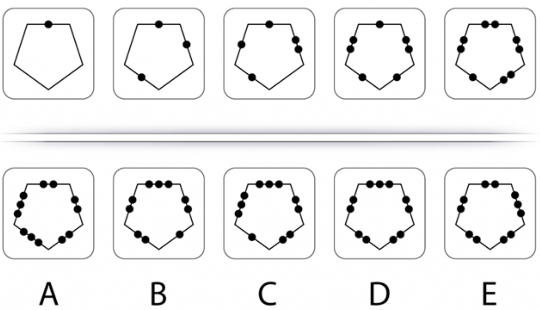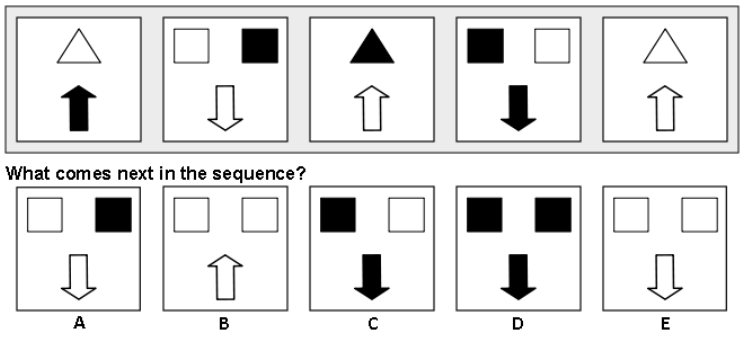Inductive Reasoning Tests: A Comprehensive Guide (2025)
An Inductive Reasoning Test is a psychometric test designed to evaluate a candidate's ability to identify patterns, logical sequences, and relationships between abstract shapes and figures. The inductive process measures problem-solving ability, abstract thinking, and non-verbal reasoning, making it a crucial test for roles that require logical thinking and decision-making.
Many global companies use inductive reasoning tests to assess candidates in engineering, IT, finance, and consulting roles to see if they can apply an inductive approach to problem solving.
In this guide, we will cover:
- ✅What is an inductive reasoning test?
- ✅Why employers use the inductive reasoning test.
- ✅Common question types and inductive reasoning examples.
- ✅How to prepare and improve your score
- ✅Common mistakes in inductive reasoning tests.
- ✅Frequently asked questions.
What is an Inductive Reasoning Test?
Inductive Reasoning Meaning
Inductive Reasoning Tests are taken to evaluate a candidate's ability to:
- 🔹Identify patterns and trends in sequences of shapes.
- 🔹Recognize logical progressions in diagrams.
- 🔹Solve problems with abstract reasoning skills.
Deductive v Inductive Reasoning
The main difference between deductive and inductive reasoning has to do with how conclusions are reached:
- ✅Inductive Reasoning: Starts with specific observations from which a conclusion is drawn using bottom up logic. This is known as induction thinking or induction in logic: whilst the conclusion is likely, it is not guaranteed.
- ✅Deductive Reasoning: Starts with a general rule or principle which is used to determine whether a conclusion is true or not using top down logic. If the rule or principle is true, the conclusion must be true: this is known as deduction logic or deductive thinking.
Who Uses Inductive Reasoning Tests?
Many multinational companies use inductive reasoning tests during their recruitment process for jobs that require strong analytical and problem-solving skills, including:
- 📊Technology & IT (Microsoft, IBM, Cisco)
- 📊Engineering & Manufacturing (Siemens, General Electric, Airbus)
- 📊Finance & Banking (J.P. Morgan, HSBC, Barclays)
- 📊Consulting & Business Services (PwC, Deloitte, Accenture)
The test is commonly used in graduate recruitment, management assessments, and technical hiring processes in order to screen candidates efficiently.
Inductive Reasoning Test Formats
The most common inductive test is the SHL Inductive Reasoning test, which has the following format:
- ✅Question type: Multiple-choice.
- ✅Test duration: 20 minutes.
- ✅Number of questions: 12 questions.
- ✅Question style: Diagram-based, identifying patterns and logical sequences.
Each question usually presents as a series of abstract shapes and patterns. Candidates must correctly select the next figure from a set of possible answers by identifying the pattern in the provided sequence.
Inductive Reasoning Examples
Below are some of the most common inductive example questions candidates will encounter in an inductive reasoning test.
1. Shape Progression & Sequences
💡 Inductive Reasoning Example:
Find the next shape in the sequence:

✅ Answer:
The shape alternates between a star (with an increasing number of points from 4 to 5 to 6), and a four-sided shape in between the stars to complete the sequence. Given the last shape in the sequence is a star, the next shape must be a 4 sided shape. From the options provided, the only 4 sided shape is Option C which is the correct answer.
2. Rotational Patterns
💡 Inductive Reasoning Example:
Find the next shape in the sequence using inductive thinking:

✅ Answer:
If we look at the difference between the first and second shape, we can see that a dot gets added on the 1st edge and 3rd edge counting clockwise. For the second shape, starting on the last dot that was added on the 3rd edge, again dots are added on the 1st edge and the 3rd edge. This repeats itself the entire sequence.
Working through the remaining shapes, we can see in the 5th picture that the last dot was added on the bottom right edge. As such, the next shape in the pattern would have dots added on the 1st edge (bottom left) and 3rd edge (top edge). Hence, the correct answer is Option D.
3. Alternating Patterns
💡 Inductive Reasoning Example:
Find the next shape in the sequence using inductive process:

✅ Answer:
1. The pattern alternates between one triangle and two squares so the correct option must contain two squares, giving all five options as possible correct answers.
2. The direction of the arrow alternates between up and down across the sequence so must be pointing down in the correct option, giving A, C, D or E.
3. There is always one black or one white square across the sequence, giving A or C as possible answers.
4. The top squares alternate colour, hence the correct shape should have a white square on the left, giving Option A as the correct answer.
4. Mirror & Reflection Patterns
💡 Inductive Reasoning Example:
Find the next shape in the sequence using deductive and inductive thinking:

✅ Answer:
Pattern 1: The stick with the black flag first mirrors on its own axis, then it turns 45 degrees clockwise. Giving B or E as possible correct answers.
Pattern 2: The stick with the red flag first turns 45 degrees clockwise, then mirrors on its own axis. Hence the correct answer is Option B.
How to Prepare for Inductive Reasoning Tests
- ✅
1. Practice Inductive Reasoning Problems
Practice with free deductive and inductive examples like the ones on our Practice Tests page.
- ✅
2. Identify Common Patterns & Relationships
- Look for rotations, size variations, and alternating patterns.
- Understand progressions and logical sequences.
- ✅
3. Use the Process of Elimination
- Remove obviously incorrect options.
- Compare remaining options for the best logical fit.
- ✅
4. Manage Your Time Efficiently
- Spend no more than 90 seconds per question.
- Skip difficult questions and return later if time allows.
Common Mistakes to Avoid
- ❌Not analyzing patterns carefully – Always look for size, shape, or directional changes.
- ❌Ignoring rotation and symmetry – Shapes often rotate clockwise, counterclockwise, or reflect.
- ❌Overcomplicating questions – Start with basic pattern recognition first.
- ❌Spending too much time on one question – Move on and return later if you are unsure.
FAQs About Inductive Reasoning Tests
1. What is the difference between Deductive and Inductive Reasoning?
Deductive reasoning applies rules to reach a certain conclusion, whilst inductive reasoning uses rules to form a probable conclusion.
Deductive thinking basically starts with a general rule to reach a sure conclusion. Whilst an inductive approach uses examples to make a likely guess.
2. Can I prepare for an Inductive Reasoning test?
Yes! Practicing pattern recognition and visual logic puzzles improves performance by helping you identify the question sequence quicker.
3. What is a good score on an Inductive Reasoning Test?
A score in the 75th percentile or above is considered strong.
4. Can I fail the Inductive Reasoning Test?
There is no pass or fail, but low scores may eliminate you from progressing further in the recruitment process.
5. Where can I find free Inductive Reasoning practice tests?
Right here on our Practice Tests page.
Ready to Practice Your Induction Thinking?
The Inductive Reasoning Test is a key assessment for roles requiring strong problem-solving and abstract reasoning skills. By practicing different question types, improving pattern recognition, and mastering time management, you can significantly boost your score.